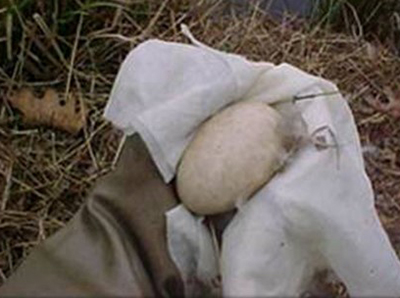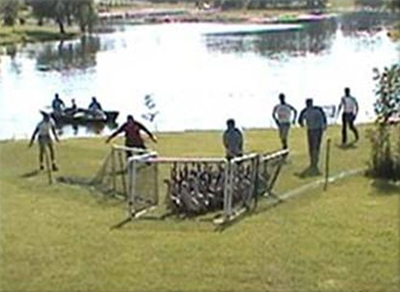Abatement
Abatement (non-lethal harassment) techniques are used to frighten and discourage geese from using a property. They are non-lethal and are legal to use on Canada geese without possessing a federal or state permit as long as geese are not injured, touched, or handled by a person, dog, or other equipment. Different abatement methods can entail audial, visual, and physical techniques, as long as local ordinances are being followed.
Abatement techniques will only be as effective as the amount of effort employed. Abatement techniques must be used repetitively each time geese appear on your property to be successful. Techniques should be used as soon as Canada geese appear on a property because they are much more difficult to frighten after they feel comfortable in an area.
The following techniques may be used to abate geese, where safe and legal to do so. Check local ordinances and laws before using any of them.
- Audial Devices
- Air horns
- Whistles
- Blank pistols
- Specialized projectiles (bangers, screamers, and whistlers)
- Cracker shells from a shotgun
- Firecrackers
- Propane cannons
- Recorded distress calls
- Visual Devices
- Motion sensor lights
- Flagging
- Eye spot balloons
- Dead goose or predator decoys
- Mylar tape
- Scarecrows
- Dogs (chasing only)
- Remote controlled devices
- Hand-held green lasers
- Physical Devices
- Garden hose
- Sprinkler
- Motion-activated sprayer
- Legal chemical repellents (must be applied following label instructions)
- Hunting

Hunting waterfowl, where safe and following local ordinances, should be encouraged during the legal waterfowl hunting seasons using approved methods. Hunting is the most effective and preferred method of removing surplus ducks and geese. Hunting also removes some of the adult breeding birds that are adding to the population.
- Egg and Nest Destruction
Nest removal can be carried out at any time, on property you own or have permission to be on, as long as no eggs or geese are present. Repeatedly removing nests can encourage breeding geese to relocate, build a new nest, or nest later in the season. It is advisable to begin nest removal as soon as geese are seen scouting nest locations and to prevent them from laying eggs in undesirable locations. Nest construction may last for several weeks, and the first egg may be laid less than 24 hours after the nest is constructed. Once the first egg is laid in a nest, no further action can legally be taken without first registering online with the U.S. Fish and Wildlife Service.

It is against federal law for anyone to destroy a Canada goose nest that contains one or more eggs without first securing permission through the U.S. Fish and Wildlife Service. Permission may be received by registering online. Landowners must register each employee or agent working on their behalf. Egg destruction can be implemented any time of year after a permit is secured. Online registration is open Jan. 1 through June 30.
Once registered, egg treatment or nest destruction can occur. Be cautious if attempting to conduct these activities yourself because Canada geese are very aggressive during the nesting period and may attack a person coming close to their nest. A person may either shake the egg for at least 60 seconds, puncture the large end of the egg with a sharp object, or coat the egg with 100% corn oil to prevent it from hatching. Only eggs that are more than 14 days old and float in the water float test should be removed from the nest. If the eggs are removed or broken too early, the goose will lay more eggs.
The eggs can be treated by using 100% corn oil and placed back in the nest. This will trick the goose into sitting on the eggs for an extended time, but the eggs will not hatch. The oil blocks the pores on the eggshell, and the egg becomes unviable.
Nest removal with eggs present is an effective way to reduce goose reproduction and reduce the local goose population in the long term. If the goose can be seen on the nest, remove the nest after she has been sitting on her eggs for 14 days. If the nest is taken earlier, she is likely to re-nest and lay new eggs, so it is important to wait for 14 days after the last egg is laid. It is probably better to leave the eggs a few days longer than two weeks, rather than take them too early.
March through April are primary egg-laying times for geese, when egg destruction methods should be used. These times may vary depending on spring temperatures and other local conditions. Nests with cold eggs should be left alone because the goose is still laying eggs. Return two weeks later to remove any nests that are cold on the first attempt. The entire nest and all eggs should be removed and placed in garbage bags. These can be sent to a landfill.
A method you can use to help you determine the age of the Canada geese eggs more accurately is the float test. Take the eggs and put them in a bucket with at least 6 inches of water. Eggs younger than 14 days will sink. These eggs should be dried off, addled, and returned to the nest. Eggs that are older than 14 days will float. These eggs should be removed unless the eggshell is pipped, which means the gosling is pecking through and ready to hatch. Leave all the eggs in a nest when one egg is pipped. All the goslings will be hatching within a few hours. Removal of live geese, including goslings, requires a separate permit.
- Relocation, Euthanasia, and Shooting Permits
For help with abatement techniques or preventing goose conflicts, please contact a District Wildlife Biologist.
It is illegal to trap, capture, relocate, or euthanize (i.e. shoot) geese without a permit except during the goose hunting season, when they can be hunted in accordance with state and federal law. For landowners experiencing economic damage or safety issues from Canada geese, a federal migratory bird depredation permit is available from the U.S. Fish and Wildlife Service. For more information and to start the permit approval process for the federal permit, contact USDA-APHIS-Wildlife Services at 765-494-6229. Permits can only be issued by DNR without the need for a federal permit from March 11 through Aug. 31 of each year.

- Domestic Geese
Domestic geese are not regulated by the Indiana Department of Natural Resources.
